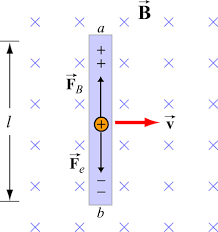(a)The pointer in the galvanometer deflects, when a bar magnet pushed or away from the coil connected to a galvanometer. Identify the phenomenon causing this deflection and write the factors on which the amount and direction of the deflection depends. State the laws describing this phenomenon.
(b) Sketch the change in flux, emf and force when a conducting rod PQ of resistance R and length l moves freely to and fro between A and C with speed v on a rectangular conductor placed in uniform magnetic field as shown in the figure.

a) When the magnet shown below is
moved “towards” the coil, the pointer or needle of the Galvanometer, which is
basically a very sensitive center, will deflect away from its center position
in one direction only. When the magnet stops moving and is held stationary with
regards to the coil the needle of the galvanometer returns back to zero as
there is no physical movement of the magnetic field. This is as
per Michael Faraday’s law of electromagnetic induction which states: “that
a voltage is induced in a circuit whenever relative motion exists between a
conductor and a magnetic field and that the magnitude of this voltage is
proportional to the rate of change of the flux”.
Factors on which amount and
direction of deflection depends are as under-
1) Increasing the number of turns of wire in the coil. – By
increasing the amount of individual conductors cutting through the magnetic
field, the amount of induced emf produced will be the sum of all the individual
loops of the coil.
2) Increasing the speed of the relative motion between the coil and the
magnet. – If the same coil of wire passed through the same magnetic field
but its speed or velocity is increased, the wire will cut the lines of flux at
a faster rate so induced emf would be produced.
3) Increasing the strength of the magnetic field. – If the same
coil of wire is moved at the same speed through a stronger magnetic field,
there will be more emf produced because there are more lines of force to cut.
b) 
a) When the magnet shown below is moved “towards” the coil, the pointer or needle of the Galvanometer, which is basically a very sensitive center, will deflect away from its center position in one direction only. When the magnet stops moving and is held stationary with regards to the coil the needle of the galvanometer returns back to zero as there is no physical movement of the magnetic field. This is as per Michael Faraday’s law of electromagnetic induction which states: “that a voltage is induced in a circuit whenever relative motion exists between a conductor and a magnetic field and that the magnitude of this voltage is proportional to the rate of change of the flux”.
Factors on which amount and direction of deflection depends are as under-
1) Increasing the number of turns of wire in the coil. – By increasing the amount of individual conductors cutting through the magnetic field, the amount of induced emf produced will be the sum of all the individual loops of the coil.
2) Increasing the speed of the relative motion between the coil and the magnet. – If the same coil of wire passed through the same magnetic field but its speed or velocity is increased, the wire will cut the lines of flux at a faster rate so induced emf would be produced.
3) Increasing the strength of the magnetic field. – If the same coil of wire is moved at the same speed through a stronger magnetic field, there will be more emf produced because there are more lines of force to cut.
b)



